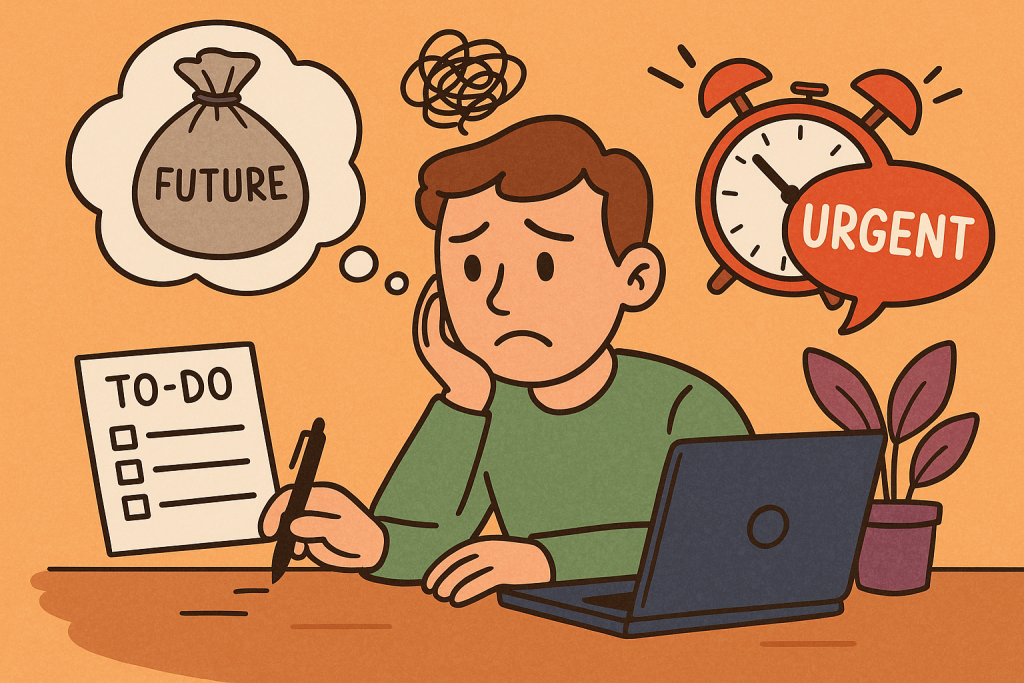Ever wonder why we avoid thinking about what’s not urgent—like long-term career planning or retirement—and instead fixate on fire drills and pings? It’s not just laziness. It’s how our brains evolved to filter for survival and immediate reward.

Present Bias & Evolution’s Shortcut
Humans exhibit present bias—a well-documented tendency to overvalue immediate rewards and downplay future gains. This bias helped ancestors survive by reacting to immediate dangers. Today, though, it nudges us toward checking notifications or urgent emails rather than tackling tasks like updating long-term goals.
Cognitive Triggers: Fear, Urgency, and Dopamine
Psychology Today identifies key triggers behind procrastination on low-urgency tasks: low perceived value, fear of failure, and lack of urgency. Without external deadlines or emotional stakes, our brain deprioritizes such tasks in favor of dopamine-rich distractions like social media.
The Modern Consequences Are Real
Delaying non-urgent tasks can lead to stress accumulation, missed opportunities, and a reactive work environment. The American Psychological Association highlights rising burnout and workplace stress—where reactive firefighting is killing long-term planning. When everything feels urgent, nothing truly gets done ahead of time.
Why We Keep Passing on Non-Urgent Thinking
- No External Pressure: Without a deadline, there’s no trigger—our brains love deadlines.
- Task Aversion + Perfectionism: Tasks without clarity or immediate reward feel unappealing—especially to perfectionists .
- Overwhelm & Decision Fatigue: When buried in urgent tasks, even small choices exhaust our cognitive bandwidth.
- Digital Distraction Culture: Alerts, social feeds, and inbox dinging hijack our attention—keeping our focus on now .
Emerging Trends & Solutions
1. Scheduled “Future Thinking Blocks”
Some companies are implementing designated times for non-urgent work—weekend planning, upskilling, or mentorship prep. It mimics urgent triggers by setting clear calendars and committing collectively.
2. Burnout Prevention & Flexible Work
Modern workplace wellness is shifting toward balancing urgent operational demands with growth and reflection time. Employees are encouraged to block weekly slots for non-urgent but important tasks—improving mental health and performance.
3. Habit Engineering Techniques
- Promise contracts: Publicly committing to long-term goals increases non-urgent task follow-through.
- Micro habits: Breaking planning into tiny, frequent actions—like 5‑min weekly reviews—reduces friction.
- Accountability partners: Sharing monthly non-urgent goals builds follow-through, especially by overcoming procrastination from fear.
4. Tech Aids for Long-Term Planning
Digital tools like goal-specific apps and reflection platforms prompt you regularly to update projections—turning non-urgent setups into habits. Early case studies show this improves goal clarity and progress.
How to Shift Your Brain’s Priorities
Step-by-Step Guide to Tackling the Unurgent
- Define & Time-Box
- Pick one non-urgent task (e.g., “update LinkedIn strategy”).
- Schedule a 15-minute weekly slot on your calendar tagged “non-urgent planning.”
- Assign Timelines & Public Payoff
- Attach a visible milestone (e.g., “outline article by July 15”).
- Tell a peer or manager—social pressure adds missing urgency.
- Use Micro-Steps
- Break the task into 5‑minute mini-actions (e.g., “search two article ideas,” “draft intro paragraph”).
- Every mini-win releases dopamine and builds momentum.
- Reward Yourself
- Follow each session with a small treat—coffee break, 10-min walk, playlist.
- Track & Reflect
- At month’s end, review progress in your slot.
- Reflect: What worked? What blocked you? Adjust next month.
- Iterate & Scale
- Add another non-urgent goal.
- Refine time slots, accountability, micro‑habits.
Real-World Success Stories
- A marketing team set aside 1 hr/week for strategic research, later achieving a 20% lift in campaign effectiveness.
- A freelancer used weekly micro-steps to build a portfolio, eventually converting it into consistent client leads.
- An HR director paused reactive tasks to institute monthly upskilling, reducing team turnover by 15%.
These examples show how shifting mental time allocation creates real gains.
Final Takeaway
We sidestep non-urgent thinking not due to laziness—but due to mental evolution, brain chemistry, and modern culture. The good news? Evidence-backed strategies—from scheduling and micro‑habits to public accountability—equip us to consciously rewire our behavior.
Reclaiming non-urgent priorities doesn’t need radical overhaul—just consistent small steps. Try one of the methods above this week and see how soon “not urgent, but important” becomes part of your rhythm.
References
Eisenhower, D. (2024). The Only Goals That End Up Mattering Are Non‑urgent. Psychology Today. Retrieved from www.psychologytoday.com
Francis, G., et al. (2022). The Mere Urgency Effect: Prioritizing Urgency Over Importance. Choice Hacking. Retrieved from www.choicehacking.com
Pychyl, T. (2012). The real reasons you procrastinate—and how to stop. The Washington Post. Retrieved from www.washingtonpost.com






